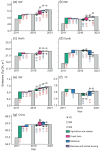Slowdown in China's methane emission growth
- PMID: 39262925
- PMCID: PMC11389614
- DOI: 10.1093/nsr/nwae223
Slowdown in China's methane emission growth
Abstract
The unprecedented surge in global methane levels has raised global concerns in recent years, casting a spotlight on China as a pivotal emitter. China has taken several actions to curb the methane emissions, but their effects remain unclear. Here, we developed the Global ObservatioN-based system for monitoring Greenhouse GAses for methane (GONGGA-CH4) and assimilate GOSAT XCH4 observations to assess changes in China's methane emissions. We find the average rate of increase in China's methane emissions (0.1 ± 0.3 Tg CH4 yr-2) during 2016-2021 slowed down compared to the preceding years (2011-2015) (0.9 ± 0.5 Tg CH4 yr-2), in contrast to the concurrent acceleration of global methane emissions. As a result, the contribution of China to global methane emissions dropped significantly. Notably, the slowdown of China's methane emission is mainly attributable to a reduction in biogenic emissions from wetlands and agriculture, associated with the drying trend in South China and the transition from double-season to single-season rice cropping, while fossil fuel emissions are still increasing. Our results suggest that GONGGA-CH4 provides the opportunity for independent assessment of China's methane emissions from an atmospheric perspective, providing insights into the implementation of methane-related policies that align with its ambitious climate objectives.
Keywords: China; Global ObservatioN-based system for monitoring Greenhouse GAses for methane; data assimilation; greenhouse gases; methane emissions.
© The Author(s) 2024. Published by Oxford University Press on behalf of China Science Publishing & Media Ltd.
Figures



References
-
- Canadell JG, Monteiro PMS, Costa MH. Global Carbon and Other Biogeochemical Cycles and Feedbacks. In: IPCC AR6 WGI 2021.
-
- Ghosh A, Patra PK, Ishijima K et al. Variations in global methane sources and sinks during 1910–2010. Atmos Chem Phys 2015; 15: 2595–612. 10.5194/acp-15-2595-2015 - DOI
LinkOut - more resources
Full Text Sources
Research Materials
Miscellaneous
